
The Yi ethnic group, with a population of 6.6 million, is mainly distributed over the provinces of Sichuan, Yunnan and Guizhou, and the Guangxi Zhuang Autonomous Region. It is the fifth largest minority nationality of China, which has rich culture heritage and long history.
Genesis
In the old mythology, at the creation of the world, the God of Gezi used the chin of the tiger to support the sky and the feet of the tiger to maintain the ground. The tiger’s left eye became the sun and its right eye became the moon. The tiger’s teeth turnedsintosthe stars, and its blood gotsintosthe sea. Then came the whole world and the people. Therefore, the Yi people treat themselves as the offspring of the Black Tiger.
Geographic distribution
There are more than one million Yis in Sichuan Province, and most of them live in an area south of the Dadu River and along the Anning River. Traditionally, this area is subdividedsintosthe Ground Liangshan Mountain area, which lies east of the Anning River and south of the Huangmao Dyke, and the Little Liangshan Mountain area, which covers the Jinsha River valley and the south bank of the Dadu River. There are over a million Yis in the Liangshan Yi Autonomous Prefecture, which holds the single largest Yi community in China. Yunnan Province has more than three million Yis, most of whom are concentrated in an area hemmed in by the Jinsha and Yuanjiang rivers, and the Ailao and Wuliang mountains. Huaping, Ninglang and Yongsheng in western Yunnan form what is known as the Yunnan Lesser Liangshan Mountain area. In Guizhou, more than half a million Yis live in compact communities in Anshun and Bijie. Several thousand Yis live in Longlin and Mubian counties in the Guangxi Zhuang Autonomous Region.

Most Yis are located in mountainous regions, some in frigid mountain areas at high altitudes, and a small number live on flat land or in valleys. The altitudinal differences of the Yi areasshavingsdifferent climates which directly affect the Yi’s living styles. Their striking differences have given rise to the old saying that "the weather is different a few miles away" in the Yi area. This is the primary reason why the Yis in various areas are so different from one another in the ways they make a living.
The Yi areas are rich in natural resources. The Jinsha River running through Sichuan and Yunnan and its tributaries surging through the Yi areas in northern and northeastern Yunnan are enormous sources of water power. The Yi areas are not only rich in coal and iron, but are also among China's major producers of non-ferrous metals. Gejiu, China's famous tin center, reared the first generation of Yi industrial workers. Various Yi areas in the Ground and Little Liangshan Mountains, western Guizhou, and eastern and southern Yunnan abound in dozens of mineral resources, including gold, silver, aluminum, manganese, antimony and zinc. Vast forests stretch across the Yi areas,swheresYunnan pine, dragon spruce, Chinese pine and other timber trees, lacquer, tea, camphor, kapok and other trees of economic value grow in great numbers. The forests teem with wild animals and plants as well as pilose antler, musk, bear gallbladders and medicinal herbs such as poris cocos.
History:
The Yi language belongs to the Tibetan-Myanmese Languagesgroupsof the Chinese-Tibetan Language Family, and the Yis speak six dialects. Many Yis in Yunnan, Guizhou and Guangxi know the Han (standard Chinese or Mandarin) language. The Yis used to have a syllabic script called the old Yi language, which was formed in the 13th century. It is estimated that the extant old Yi script has about 10,000 words, of which 1,000 are words of everyday use. A number of works of history, literature and medicine as well as genealogies of the ruling families written in the old Yi script are still seen in most Yi areas. Many stone tablets and steles carved in the old Yi script remain intact. Since the old Yi language is not consistent in word form and pronunciation, it was reformed after liberation for use in books and newspapers.
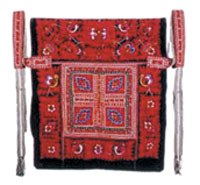 
Historical records written in the Han and the old Yi languages show that the ancestors of the Yi, Bai, Naxi, Lahu and Lisu ethnic groups were closely related with ancient Di and Qiang people in west China. In the period between the 2nd century B.C. and the early Christian era, the activities of the ancient Yis centered around the areas of Dianchi in Yunnan and Qiongdou in Sichuan. After the 3rd century, the ancient Yis extended their activities from the Anning River valley, the Jinsha River, the Dianchi Lake and the Ailao Mountains to northeastern Yunnan, southern Yunnan, northwestern Guizhou and northwestern Guangxi.
In the Eastern Han (25-220), Wei (220-265) and Jin (265-420) dynasties, inhabitants in these areas came to be known as "Yi," the character for which meant "barbarian." After the Jin Dynasty, the Yis of the clan named Cuan became rulers of the Dianchi area, northeastern Yunnan and the Honghe (Red) River area. Later those places were called "Cuan areas" which fellsintosthe east and west parts. The inhabitants there belonged to tribes speaking the Yi language.
In the Tang and Song dynasties, the Yis living in "East Cuan" were called "Wumans." In different historical periods, "Cuan" changed from the surname of a clan to the name of a place, and further to the name of a tribe. In the Yuan and Ming dynasties, "Cuan" was often used to refer to the Yis. After the Yuan Dynasty, part of "Cuan" acquired the name "Luoluo" (Ngolok), which probably originated from "Luluman," one of the seven "Wuman" tribes in the Tang Dynasty. From that time on, most Yis called themselves "Luoluo," although many different appellations existed. This name lasted from the Ming and Qing dynasties till liberation.
Ancient Yis experienced a long primitive society in the Stone Age. Legends and records written in the old Yi script show that the Yis went through a matriarchal age in ancient times. Annals of the Yis in the Southwest records that the Yi people in ancient times "only knew mothers and not fathers," and that "women ruled for six generations in a row." Patriarchy camesintosbeing at least 2,000 years ago.
Roughly in the 2nd and 3rd centuries B.C., the Yis living around the Dianchi Lake in Yunnan entered class society. In the early Han Dynasty, prefectures were set up in this area, and the chief of the Yi people was granted the title "King of Dian" with a seal. Around the 8th century, a slave state named "Nanzhao" was established in the northern Ailao Mountain and the Erhai areas, with the Yis as the main body and the Bai and Naxi nationalities included. The head of the state was granted the title "King of Yunnan." In the same period, "Luodian" and other groups of slave owners and regimes appeared in the Yi areas in Guizhou. In 937, the state of "Dali" superseded "Nanzhao," when it collapsed under the blows of slave and peasant uprisings. From then on, the slave system of the Yis in Yunnan gradually disintegrated.
After the 13th century, "Dali" and "Luodian" were conquered one after the other by the Yuan Dynasty, which set up regional, prefectural and county governments and military and civil administrations in the Yi areas in Yunnan, Guizhou and Sichuan, appointing hereditary headmen to rule the local inhabitants. By the end of the Yuan Dynasty, the feudal economy of the Yi landlords in Yunnan had developed rapidly, but remnants of the manorial economy and slavery still existed to varying extents in the secluded areas. The Ming Dynasty used both administrative officials from elsewhere and local hereditary headmen, and some of the governments consisted of both types of administrators, expanding the influence of the feudal landlord economy. The large number of Han immigrants also promoted economic growth in the Li areas. The Qing Dynasty abolished the system of appointing hereditary headmen and confirmed the appointment of administrative officials. This enhanced its direct rule over the Yi areas, hastened the disintegration of the manorial economy and firmly established the feudal landlord economy.
 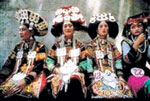 
The Yi people have a glorious tradition of revolutionary struggle. In the recent 100 years or more the Yis waged powerful anti-imperialist and anti-feudal struggles as well as those against slave owners. Influenced by the Taiping Revolution (1851-1864), the struggles waged by the Yis and other nationalities against the Qing government lasted more than a decade.
In 1935, the Chinese Red Army pushed north to resist the Japanese invaders. The troops on the historic Long March passed through the Yi areas, leaving a good and deep impression on the Yis wherever they went. On their way through northwestern Guizhou and northeastern Yunnan, the Red Army cracked down on local tyrants, wicked gentry and corrupt officials, and opened their barns to relieve the starving Yis. The Red Army distributed confiscated grain, salt, ham, clothes and other such goods among the Yis and people of other ethnic groups, who in return gave enthusiastic assistance to it. Many young Yis joined the Army.
After crossing the Jinsha River, the Red Army pushed towards the Dadu River in two prongs from Yuexi and Mianning. Supported by the Army, the Yis and Hans in Mianning established the Worker-Peasant-Soldier Democratic Government of the county, formed revolutionary troops, abolished the "hostage system" imposed by the Kuomintang government, and set free several hundred Yi headmen and their relatives held as hostages. The Red Army strictly observed discipline, firmly implemented the Chinese Communist Party's policy for minority groups, declared that it aimed to emancipate the minority groups, and proclaimed that all poor Yis and Hans were kith and kin. It called on the Yi people to unite with the Red Army and overthrow the warlords and fight for national equality. Inspired by the Red Army's policies, Yuedan the Junior, the chieftain of a Yi clan in Mianning County, enteredsintosalliance with the Red Army General Liu Bocheng. Helped by the Yis and the chieftain, the Red Army troops passed through the Yi areas without a hitch and won the victory of capturing the Luding Bridge and forcing the Dadu River.
The Ten-month Solar Calendar
More than 4000 years before, the Yi’s ancestor had already created an accurate calendric system which separated one yearsintos10 months. Every two months is a season so there are five seasons a year. Each month has 36 days. The left 5-6 days will be New Year Festival. Therefore according to the Yi nationality’s calendar the time that the earth turns around the sun will be 365.25 days. Considering the time this calendar was born, this system is unbelievable amazing.
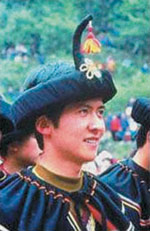 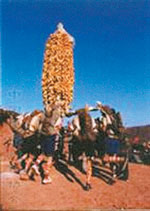 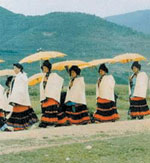
Festival
Yi nationality has many traditional festivals such as the Tenth Month Festival, the Torch Festival ,some area festivals and fete ceremonies.
However, the most important festival for Yi people is the Torch Festival.
On the 24th of the sixth lunar month, when the handle of the Big Dipper turns upward, Torch Festival, Yi people's New Year according to Yi calendar begins. Torches are kindled at night to expel evil and pray for prosperity. Many activities are held, including wrestling, bull fighting and horse racing.
The festival originated from the legend about the battle between an ancient Yi hero and a Giant of the God. The hero wrestled and beat him, which irritated the God. Insgroupsto revenge, the God sent evils and pests to damage the crops. The hero taught his people to eliminate evils and pests with torches. From now on, Yi people begin to prosper. The festival is held to commemorate him.
Custom:
Wedding:
The Yi bride’s wedding dress must be made by herself and his mother together with her sisters during the month before her wedding. This dress can’t be sent or sold to the others .And this dress will also be worn at her funeral.
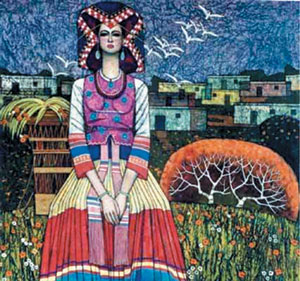
At the day of wedding, the bridegroom will have to snatch a pair of trousers which is given by the bride from the bridesmaid. Only after the bridegroom gets this trousers, they can hold the ceremony.
When the family of bride’s or bridegroom’s entertain the guests, all they need to do is to prepare the dishware. The guests will bring the food.
Style:
Yi nationality are very famous for their beautiful silver ornaments. The Finery of nationality differs in different regions. The three sections are: the Yinuo style, Shengzha style, and Suodi style.
Yi costume is great in variety, with different designs for different places. In the Liangshan Mountains and west Guizhou, men wear black jackets with tight sleeves and right-side askew fronts, and pleated wide-bottomed trousers. Men in some other areas wear tight-bottomed trousers. They grow a small patch of hair three or four inches long on the pate, which is named "Zier", and wear a turban made of a long piece of bluish cloth. The end of the cloth is tiedsintosthe shape of a taper jutting out from the right-hand side of the forehead. Women wear laced or embroidered jackets and pleated long skirts hemmed with colorful multi-layer laces. Some women wear black turbans, while middle-aged and young women prefer embroidered square kerchiefs with the front covering the forehead like a rim. They also wear earrings and like to pin silver flowers on the collar. Men and women, when going outdoors, wear a kind of dark cape made of wool and hemmed with long tassels reaching to the knee.
The Proprieties and Taboos
Usually there is a stove in Yi people’s room. Spittingsintosthe stove is forbidden, and it is also forbidden to be naked around the stove.
To urinate facing the sun is considered very rude according to the Yi.
Yi women are prohibited from sunning the clothes at the aisles and near the beehive.
Even if you don’t drink or smoke, you should not refuse the smoke and wine from the host which will be treated as very insolent. You should accept the cigarettes and the alcohol but not to smoke or drink insgroupsto show your respect to the host,but you could not smoke or drink.
|
![]() 本网站由北京信息港提供网络支持
本网站由北京信息港提供网络支持










